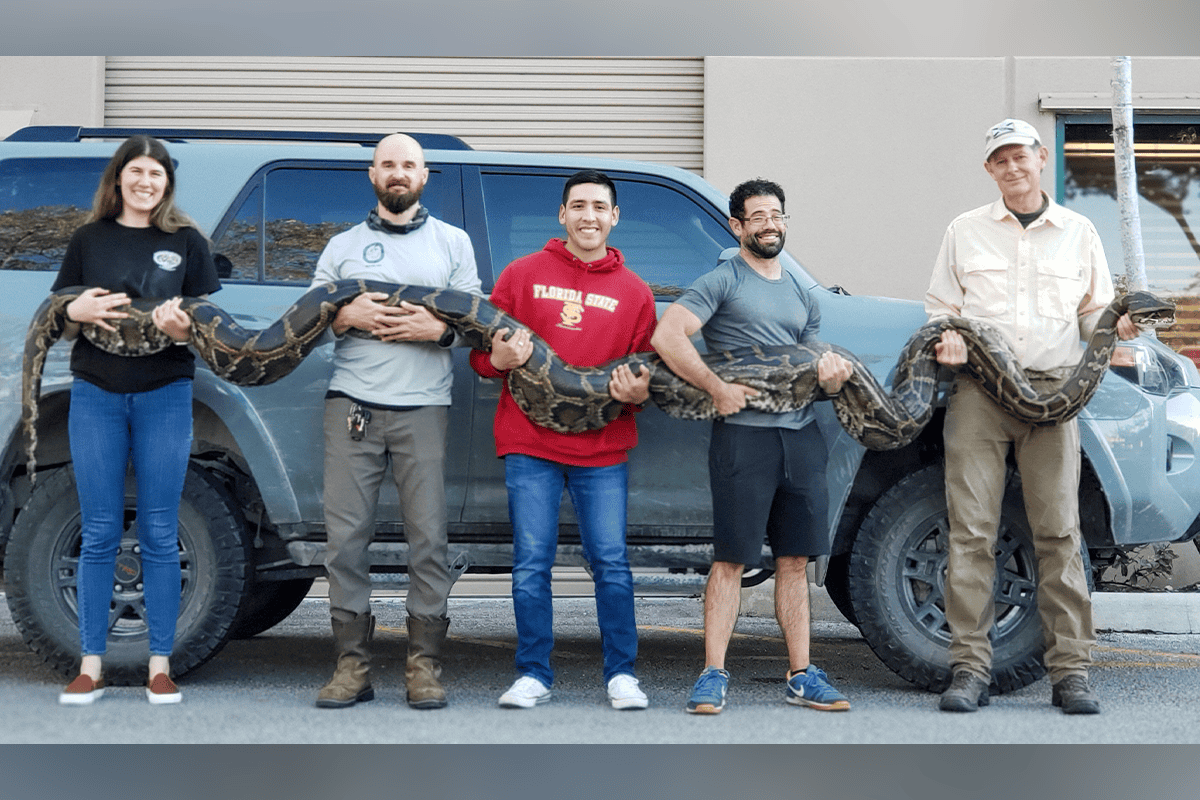Fourth-heaviest Burmese python caught in Everglades by Florida Fish and Wildlife Commission

FORT LAUDERDALE, Fla. – The fourth heaviest Burmese python was recently captured in March by the Florida Fish and Wildlife Commission in the Everglades’ Francis S. Taylor Wildlife Management Area.
According to the Florida Fish and Wildlife Commission, or FWC, the snake weighed 176.6 pounds and measured 16.9 feet long, making it the fourth largest and 22nd longest Burmese python on record. The giant snake was caught by Kurt Cox, a contractor with the FWC’s Python Action Team Removing Invasive Constrictors, or PATRIC.
Launched in 2017, PATRIC “engages qualified individuals with nonnative constrictor control efforts.” The program also works with the South Florida Water Management District’s, or SFWMD, Python Elimination Program.
The program specifically allows the public to hunt Burmese pythons on designated lands in Monroe, Miami, Dade, Broward, Collier, Hendry, Lee, and Palm Beach counties.
As of January 2023, 11,000 Burmese pythons have been removed by PATRIC and the SFWMD, while 18,000 have been removed overall.
Per FWC records, the heaviest Burmese python removed from Florida was a 215-pound, 17.7-foot female by Ian Bartoszek with The Conservancy of Southwest Florida in December of 2021. The longest snake removed was a 19-foot female python, also weighing 125.56 pounds, by Jake Waleri in July 2023.
While recent catches in Florida have been inherently large, Burmese pythons tend to grow between six and nine feet. Although, the snake has been reported to reach over 20 feet in length.
Burmese pythons are considered invasive to Florida, meaning the snake does not belong in its environment. The snake itself is a large, nonvenomous constrictor primarily found in the Everglades in South Florida.
Native to Asia, the snake’s habitat stretches from India to China and portions of southern Indonesia. The snake can also be documented in extremes in elevation, from the lowlands of Cambodia to the foothills of Nepal in the Himalayas.
The snake can be identified by its tan color with dark blotches along the back and sides. Its markings are similar to puzzle pieces and they have a pyramid-shaped head with a dark, arrowhead-shaped wedge extending to the nose.
While finding comfort in the Everglades, the Burmese Python has reportedly began slithering into other parts of Florida. The FWC has confirmed sightings of the snake in Southwest Florida, including Charlotte, Lee, and southern Sarasota County.
The snake has been specifically documented within the townships of Rotonda, Placida, Englewood, Gasparilla Island, and Port Charlotte.
In 2020, the FWC received a rise in python reports which resulted in an increase in surveys around the region. Over that period, 12 of 25 pythons were captured or found dead on the road and removed, including seven carcasses being turned over to the commission.
Regardless of mitigation, the Burmese python has reproduced and established a home in Florida since at least 2000. Its unwelcome arrival to the state began with its accidental or intentional release through the pet trade largely in the 1980s.
Although, sightings of the snake in South Florida trace as far back as 1979. Eversince, its population in the state has suffocated the Everglades region.
Overall, the Burmese Python population has been estimated between 100,000 and 300,000 in the Everglades. As many as 100,000 snakes also were imported to the United States, largely to Florida, between 1996-2006.
With their population booming and seemingly expanding, wildlife biologists in Southwest Florida have used male pythons to find the whereabouts of female pythons. The “snitching,” in part, helps researchers understand the snake’s habitat and better control its population by removing them from the region.
“We have a tracking program at the Conservancy that began in 2013 and currently tracks 40 Burmese pythons,” Bartoszek said to Florida’s Voice. “Males are referred to as scout snakes and they help lead us to females during the breeding season that we humanely remove.”



